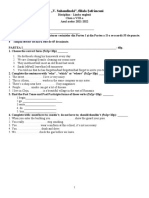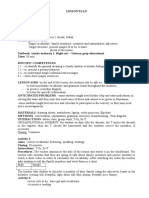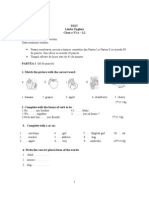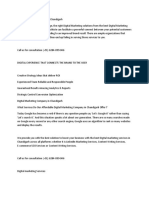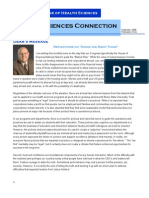Proiect Didactic Cls. A III-A
Proiect Didactic Cls. A III-A
Uploaded by
CristinaAnaisCopyright:
Available Formats
Proiect Didactic Cls. A III-A
Proiect Didactic Cls. A III-A
Uploaded by
CristinaAnaisOriginal Description:
Original Title
Copyright
Available Formats
Share this document
Did you find this document useful?
Is this content inappropriate?
Copyright:
Available Formats
Proiect Didactic Cls. A III-A
Proiect Didactic Cls. A III-A
Uploaded by
CristinaAnaisCopyright:
Available Formats
LESSON PLAN
Name: Cristea Cristina
School: coala Gimnazial Pictor Nicolae Grigorescu - Titu
Date: 4th of April, 2017
Class:3rd grade
Time of Lesson: 50 min.
Textbook: Limba modern englez, Ed. BOOKLET
Unit / Lesson: The Mystery Agency / Lesson 3- Daily Routines
Aim: To help students use Present Simple Tense to describe their daily activities.
Competences:
At the end of the lesson the students will be able to:
-to use correctly the structures of Present Simple ;
-to describe their routine using Present Simple;
-to improve their vocabulary related to daily activities.
Objectives:
Cognitive objectives:
To improve their knowledge of Present Simple form and functions;
To encourage students to talk freely about routine;
To provide students more practice on pronunciation and vocabulary;
To develop and practice the productive skills (speaking) and the receptive skills (listening).
Affective objectives:
To create a warm atmosphere;
To help students enjoy speaking English.
Teaching materials:
OHP, textbooks, digital textbook, notebooks, board, flashcards, worksheets
Anticipated language problems:
- Pupils might have difficulties in pronuncing some words in the text;
- Pupils may forget how to use correctly Present Simple at affirmative, negative and
interrogative forms;
- Pupils might start using Romanian instead of English when talking about their daily
activities.
Possible solutions:
-The teacher must help pupils with the pronunciation of difficult words;
-T will prompt the cards with the form of Present Simple in case pupils forget the grammar
rules.
Methods: conversation, explanation, dialogue, practice, game.
Procedure:
Warm-up Timing:
Speaking 2 min.
The teacher (T) greets the students (Ss) and they greet back.
T checks the homework.
Lead-in / Presentation Timing:
Speaking 7 min.
The T tells the objectives and the subject matter of the lesson, raising the Ss curiosity
this way. (We are going to consolidate our knowledge of Present Simple Tense. Lets
start by remembering how its formed.)
The T shows the sheet with the aff./ neg. / int. forms of the studied Tense.
Ss read the examples and translate them.
Practice - Activity 1: Timing:
Listening / Reading 15 min.
The T asks Ss to open their textbooks at page 26.
She tells Ss that they will listen to the audio text. Then she names some pupils (one
for each character in the text) to come in front of the class and read the text
themselves. T will help them with the pronunciation of difficult words.
Practice - Activity 2: Timing:
Speaking / Writing 5 min.
T asks the Ss to find in the texts some of the actions (verbs) at Present Simple.
Ss answer and afterwards translate them.
T writes on the board the title of the lesson and the moments of the day from the text
(in the morning / in the afternoon / in the evening) and asks the Ss to write down in
their notebooks too. She explains then that they can be used with daily activities.
T tells Ss to complete the sentences in ex. 3/ p.27.
Practice - Activity 3: Timing:
Writing / Speaking 10 min.
T hands out some activities flashcards.
T asks Ss to work in pairs and write down sentences at aff., neg., or int. form based on
the pictures they received (with daily routine), using Present Simple and moments of
the day form the blackboard.
The pair who finishes first reads the sentences aloud, showing their flashcard to the
rest of the class.
Practice - Activity 4: Timing:
Listening / Speaking 5 min.
T tells Ss that they will play Simon says using activities from ex. 5 / p.27
T gives them examples first.
Practice - Activity 5: Timing:
Listening / Speaking 5 min.
T plays the song This is the way I brush my teeth.
Ss listen and try to sing it along miming the activities.
Follow-up Homework assignment: Timing:
1 min.
The T asks Ss if they have questions about the lesson.
T gives Ss worksheets with Present Simple exercises as homework and explains them
what they have to do.
You might also like
- Planificare Pe Unitati Si Detalieri de Continut VII Art-KlettDocument15 pagesPlanificare Pe Unitati Si Detalieri de Continut VII Art-KlettOana Roman88% (8)
- Test Initial Engleza A 7-ADocument4 pagesTest Initial Engleza A 7-AMonica Gilca75% (4)
- Plan de Lectie Engleza Clasa A 5 ADocument3 pagesPlan de Lectie Engleza Clasa A 5 Ageorgemut_104805260100% (8)
- Test Initial Engleza Clasa A 6 A L2Document1 pageTest Initial Engleza Clasa A 6 A L2Liliana Gheorghe100% (2)
- LitCharts War PhotographerDocument18 pagesLitCharts War PhotographerDavid100% (1)
- Test Initial Engleza A Viiia Cu Matrice Si BaremDocument4 pagesTest Initial Engleza A Viiia Cu Matrice Si BaremGianina Ene100% (2)
- Plan de Lectie Engleza PregatitoarDocument5 pagesPlan de Lectie Engleza PregatitoarAlexa Alex100% (1)
- Lesson Plan Fairyland III at The ToyshopDocument5 pagesLesson Plan Fairyland III at The ToyshopRoxana Neagu100% (3)
- LESSON PLAN CLASA A IV A, Inspectia A II ADocument10 pagesLESSON PLAN CLASA A IV A, Inspectia A II ADumitruRaluca100% (2)
- Plan Lectie EnglezaDocument3 pagesPlan Lectie EnglezaAnca Tranca100% (1)
- III Unit 4a at The ToyshopDocument3 pagesIII Unit 4a at The ToyshopAna-Maria Gugu100% (1)
- Test Initial Engleza A 8a Cu Matrice Si BaremDocument4 pagesTest Initial Engleza A 8a Cu Matrice Si BaremTatiana Beileșen100% (1)
- Initial English Test 8 Grade (L) : Name: Date .................................Document3 pagesInitial English Test 8 Grade (L) : Name: Date .................................mihaela cimbru100% (3)
- Plan de Lectie A 4 A My House-BOOKLETDocument4 pagesPlan de Lectie A 4 A My House-BOOKLETStelli OanaNo ratings yet
- Plan de Lectie Clasa A Viii A DefinitivatDocument10 pagesPlan de Lectie Clasa A Viii A DefinitivatGianina MihăicăNo ratings yet
- Plan Lectie V Revision, Present SimpleDocument4 pagesPlan Lectie V Revision, Present SimpleBogdan Zancu75% (4)
- Plan Lectie InspectieDocument4 pagesPlan Lectie Inspectiemoni_76100% (1)
- Plan de Lectie Lb. EnglezaDocument2 pagesPlan de Lectie Lb. EnglezaDiana GabrielaNo ratings yet
- Plan Clasa A 3a, Where's MissyDocument10 pagesPlan Clasa A 3a, Where's MissyRalucaFilipNo ratings yet
- Clasa A4a Animal ElectionsDocument6 pagesClasa A4a Animal ElectionsRoxana Madalina Albu100% (2)
- Plan de Lectie Limba EnglezaDocument5 pagesPlan de Lectie Limba EnglezaCosmina Catina Mihaila100% (3)
- Planificare Cls Viii Art KlettDocument5 pagesPlanificare Cls Viii Art KlettCAMELIA VASILICHENo ratings yet
- Plan de Lectie Engleza-Recapitulare Cls PregatitoareDocument3 pagesPlan de Lectie Engleza-Recapitulare Cls PregatitoareStelli Oana100% (1)
- Plan de Lectie, Cls A VaDocument3 pagesPlan de Lectie, Cls A Vasio3067% (3)
- Plan de Lectie Pregatitoare Rooms of The HouseDocument5 pagesPlan de Lectie Pregatitoare Rooms of The HouseMironescu RazvanNo ratings yet
- Plan Lectie EnglezaDocument3 pagesPlan Lectie Englezanbeuca100% (1)
- Plan de Lectie Evaluare Clasa 5-PAULADocument10 pagesPlan de Lectie Evaluare Clasa 5-PAULALuana Ivan100% (1)
- Metodica SfaturiDocument25 pagesMetodica Sfaturiaqua_maris100% (1)
- Test Paper Clasa IVDocument2 pagesTest Paper Clasa IVAna MAna100% (7)
- Clasa A V-A Plan de Lectie Progress Check Units 1, 2Document6 pagesClasa A V-A Plan de Lectie Progress Check Units 1, 2Andreea Serban100% (1)
- Plan de Lectie Clasa A 5aDocument3 pagesPlan de Lectie Clasa A 5aCarmen SimionovNo ratings yet
- The Betfair Football Betting Systemv2Document10 pagesThe Betfair Football Betting Systemv2Alvin Jantjies100% (2)
- Proiect Didactic Cls. A IV-ADocument3 pagesProiect Didactic Cls. A IV-ACristinaAnais100% (8)
- LESSON PLAN Clasa Pregatitoare ARACIPDocument5 pagesLESSON PLAN Clasa Pregatitoare ARACIP85flori100% (1)
- Lesson Plan - in The Old HouseDocument8 pagesLesson Plan - in The Old HouseMicle Gheorghe-mihaiNo ratings yet
- Lesson Plan Body Parts PregatitoareDocument7 pagesLesson Plan Body Parts PregatitoareNuta ToniaNo ratings yet
- Plan de Lectie Clasa A IV-a Knights and CastlesDocument4 pagesPlan de Lectie Clasa A IV-a Knights and CastlesȘtefania Vasile0% (1)
- Test Initial Engleza A8aDocument4 pagesTest Initial Engleza A8aMaria Adam100% (1)
- Titularizare Limba Și Literatura Engleză 2015 VariantăDocument2 pagesTitularizare Limba Și Literatura Engleză 2015 VariantăRoxanaGaraiman100% (2)
- Test Initial Lb. Engleza Clasa A IX-a L1Document3 pagesTest Initial Lb. Engleza Clasa A IX-a L1Strafalogea SerbanNo ratings yet
- Plan Lectie 3 CANDocument9 pagesPlan Lectie 3 CANScoala Gimnaziala FrasinNo ratings yet
- Planificare Pe Unitati-Cae Gold 10Document5 pagesPlanificare Pe Unitati-Cae Gold 10vaida ameliaNo ratings yet
- Plan de Lectie, Weather, Cls 4 Ok Ok OkDocument4 pagesPlan de Lectie, Weather, Cls 4 Ok Ok OkTyny TynutzaNo ratings yet
- Planificare Module Cls 3 Ed ArtDocument17 pagesPlanificare Module Cls 3 Ed ArtCristina Pop100% (1)
- Engleza - Clasa 1 - Plan de LectieDocument3 pagesEngleza - Clasa 1 - Plan de LectieBogi BalogNo ratings yet
- Proiect Didactic Cls.IDocument3 pagesProiect Didactic Cls.ICristinaAnais100% (2)
- English For Kids - Planificare + UnitatiDocument15 pagesEnglish For Kids - Planificare + UnitatiCamelia Ciurdas100% (2)
- Clasa A III-a Plan de Lectie HideDocument5 pagesClasa A III-a Plan de Lectie HidedarkbluNo ratings yet
- Proiect Didactic CLOTHESDocument4 pagesProiect Didactic CLOTHESMaricela TopaleaNo ratings yet
- LESSON PLAN Clasa 1 DefitivatDocument3 pagesLESSON PLAN Clasa 1 DefitivatMaria Alexandra100% (1)
- Nan Ema - Grad 2 - Clasa 2 - I Can SingDocument3 pagesNan Ema - Grad 2 - Clasa 2 - I Can SingPacurar Emma100% (1)
- Initial Test Paper 8bDocument6 pagesInitial Test Paper 8bSimonaMaunaNo ratings yet
- Test Initial 8Document3 pagesTest Initial 8GGNo ratings yet
- Model Lucrare Grad IDocument96 pagesModel Lucrare Grad IIoana MandikNo ratings yet
- Evaluare Initiala LB Engleza Cls 7 l1 Barem de Evaluare Si de NotareDocument1 pageEvaluare Initiala LB Engleza Cls 7 l1 Barem de Evaluare Si de NotareBoss BalanNo ratings yet
- Lesson Plan 2 Plan de LectieDocument4 pagesLesson Plan 2 Plan de LectieMihaita BossNo ratings yet
- Subiecte Examen de Corigenta Clasa A 7.aDocument2 pagesSubiecte Examen de Corigenta Clasa A 7.alexxxy100% (1)
- Test Initial Clasa VIDocument2 pagesTest Initial Clasa VIAnamaria Plopeanu100% (3)
- Subiecte Titularizare Definitivat Engleza Over The YearsDocument4 pagesSubiecte Titularizare Definitivat Engleza Over The YearsDanielaCteacher100% (2)
- Proiect Didactic Cls A III ADocument3 pagesProiect Didactic Cls A III ACristina100% (1)
- Lesson Plan: TH H STDocument2 pagesLesson Plan: TH H STpopaflorianNo ratings yet
- Lesson 2 - GrammarDocument6 pagesLesson 2 - GrammarGaby KramerNo ratings yet
- Basic Principles For A Good Nutrition Picture Description Exercises Reading Comprehensio 88580Document2 pagesBasic Principles For A Good Nutrition Picture Description Exercises Reading Comprehensio 88580CristinaAnaisNo ratings yet
- Nutrition Nutrients Mind Map and Exercises - 20946Document4 pagesNutrition Nutrients Mind Map and Exercises - 20946CristinaAnaisNo ratings yet
- The Portrait of A LadyDocument5 pagesThe Portrait of A LadyCristinaAnaisNo ratings yet
- English Conversation For BeginnersDocument15 pagesEnglish Conversation For BeginnersCristinaAnais100% (1)
- 0 Test Initial Cls A6a l2 EnglDocument2 pages0 Test Initial Cls A6a l2 EnglCristinaAnaisNo ratings yet
- Poems-1,776 in All-And Emerge With Almost No Sense of The Time in Which She Lived. of Course, Social andDocument3 pagesPoems-1,776 in All-And Emerge With Almost No Sense of The Time in Which She Lived. of Course, Social andCristinaAnaisNo ratings yet
- Eugene O'Neill Mourning Becomes Electra: SourceDocument2 pagesEugene O'Neill Mourning Becomes Electra: SourceCristinaAnaisNo ratings yet
- Proiect Didactic Cls.IDocument3 pagesProiect Didactic Cls.ICristinaAnais100% (2)
- She Doesn't Usually ... Get Up at Half Past Six.: He Always WearsDocument2 pagesShe Doesn't Usually ... Get Up at Half Past Six.: He Always WearsCristinaAnaisNo ratings yet
- Plan de Lectie Titularizare 2017Document3 pagesPlan de Lectie Titularizare 2017CristinaAnais100% (1)
- S + Have / Has + Past Participle: Form AffirmativeDocument2 pagesS + Have / Has + Past Participle: Form AffirmativeCristinaAnaisNo ratings yet
- Halloween Crossword1Document2 pagesHalloween Crossword1CristinaAnaisNo ratings yet
- World ClassDocument8 pagesWorld ClassCristinaAnaisNo ratings yet
- Test Paper The Passive 7Document3 pagesTest Paper The Passive 7CristinaAnais100% (2)
- Planificare Fairya 2abDocument3 pagesPlanificare Fairya 2abCristinaAnaisNo ratings yet
- Planificare High Flyer CL A VII ADocument3 pagesPlanificare High Flyer CL A VII ACristinaAnaisNo ratings yet
- Direct MethodDocument4 pagesDirect MethodCristinaAnais100% (1)
- Traveling Through The First Epistle of JohnDocument52 pagesTraveling Through The First Epistle of JohnAaron Garner100% (1)
- The Art of Perception Management in Information Warfare TodayDocument8 pagesThe Art of Perception Management in Information Warfare TodaySudheer KumarNo ratings yet
- Sign Structures: Jean Marie KlinkenbergDocument24 pagesSign Structures: Jean Marie Klinkenbergdiana fe mataNo ratings yet
- Photoshop Scripting GuideDocument91 pagesPhotoshop Scripting GuideRinoCalifanoNo ratings yet
- Indemnity Bond Duplicate KVPDocument3 pagesIndemnity Bond Duplicate KVPMKNo ratings yet
- DLL - Tle-Ia 6 - Q3 - W4Document3 pagesDLL - Tle-Ia 6 - Q3 - W4joraldNo ratings yet
- Digital Marketing Company in ChandigarhDocument8 pagesDigital Marketing Company in ChandigarhDigital Marketing Company in ChandigarhNo ratings yet
- Ashtanga Yoga PosesDocument25 pagesAshtanga Yoga PosesadrianstanroNo ratings yet
- Medha Patkar NYCposterDocument1 pageMedha Patkar NYCposterdrstrangelurveNo ratings yet
- Samantha Kautz Letter of RecommendationDocument1 pageSamantha Kautz Letter of Recommendationapi-263763100No ratings yet
- Calculation of Load Capacity of Gears in Random Varying Exploitation ConditionsDocument9 pagesCalculation of Load Capacity of Gears in Random Varying Exploitation ConditionsthisisjineshNo ratings yet
- Surah Kafiroon - Dream Tafseer Notes - Nouman Ali KhanDocument16 pagesSurah Kafiroon - Dream Tafseer Notes - Nouman Ali Khanspeed2kx50% (2)
- Grammar in Use Translation MethodDocument14 pagesGrammar in Use Translation MethodsartikaNo ratings yet
- Learning Objectives:: Case 6. Epidemic AsthmaDocument13 pagesLearning Objectives:: Case 6. Epidemic AsthmaGaluh Ajeng PangestikaNo ratings yet
- RA 110 Radiographic Techniques Packet Test 1Document20 pagesRA 110 Radiographic Techniques Packet Test 1sabba_420No ratings yet
- Issues On The Permissibility of Tawarruq Contracts Draft 1Document19 pagesIssues On The Permissibility of Tawarruq Contracts Draft 1Abdul Aziz Mohd Nor100% (1)
- DLL Pe q2 WK 1 BasketballDocument3 pagesDLL Pe q2 WK 1 BasketballRuth AramburoNo ratings yet
- Connection 2008 SeptemberDocument8 pagesConnection 2008 SeptemberBoiseState100% (1)
- Solutions For High Availability and Disaster Recovery With MySQLDocument42 pagesSolutions For High Availability and Disaster Recovery With MySQLNoyeem MahbubNo ratings yet
- Gap Analysis - IsO 14001-2015Document3 pagesGap Analysis - IsO 14001-2015niyas1978No ratings yet
- SYNOPSIS - Hospital ManagementDocument5 pagesSYNOPSIS - Hospital ManagementRahul singhNo ratings yet
- Icici BankDocument66 pagesIcici BankMudita BhatnagarNo ratings yet
- 6 Essential Skills For Reading ComprehensionDocument5 pages6 Essential Skills For Reading ComprehensionSaleem Raza100% (1)
- Menu Cake Updated23 - RevDocument12 pagesMenu Cake Updated23 - RevRheza AdelaNo ratings yet
- Bse Eng B2021 LettersDocument10 pagesBse Eng B2021 LettersClaudine RosalesNo ratings yet
- Purchase Money MortgageDocument6 pagesPurchase Money MortgageJames Bradley Stoddart100% (1)
- Week-Cpar Module 4Document16 pagesWeek-Cpar Module 4MARK IAN COMADRENo ratings yet
- Fluid Rheology and Rheological Models - NEWDocument47 pagesFluid Rheology and Rheological Models - NEWIda Nurdiyana Mohd YunusNo ratings yet











